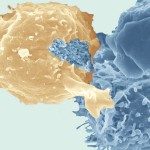Link to Pubmed [PMID] – 25698621
Curr Opin Virol 2015 Feb;10:47-55
Most viral pathogens that have emerged in humans have originated from various animal species. Emergence is a multistep process involving an initial spill-over of the infectious agent into single individuals and its subsequent dissemination into the human population. Similar to simian immunodeficiency viruses and simian T lymphotropic viruses, simian foamy viruses (SFV) are retroviruses that are widespread among non-human primates and can be transmitted to humans, giving rise to a persistent infection, which seems to be controlled in the case of SFV. In this review, we present current data on the discovery, cross-species transmission, and molecular evolution of SFV in human populations initially infected and thus at risk for zoonotic emergence.

